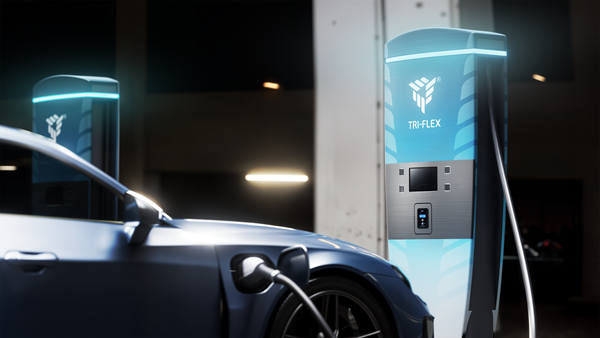Tritium, a global leader in DC fast chargers for electric vehicles, has unveiled its revolutionary TRI-FLEX charging platform at ACT Expo 2025 in Anaheim, California. The platform features a next-generation distributed architecture that enables charge point operators to scale from four up to 64 charge points easily. This ultra-scaling approach addresses critical infrastructure challenges as the EV market transitions from early adoption to mainstream over the next several years.
“Today marks a paradigm shift in EV charging infrastructure,” said Arcady Sosinov, Tritium’s CEO, during the unveiling at ACT Expo. “TRI-FLEX is not just an incremental improvement but a fundamental reimagining of distributed charging architecture designed to scale efficiently at the speed of coming demand in the market.”
As global EV sales approach 20% of total car sales and the U.S. EV fleet is projected to reach 27 million by 2030, conventional charging infrastructure faces critical limitations in scalability, grid capacity and flexibility. TRI-FLEX addresses these challenges through several industry-first innovations:
Powerful Performance & Flexibility: The core of the platform is the TRI-FLEX Hub, a power conversion system that grows with your needs – from 400kW to 1.6MW of AC power and up to 3.2MW of DC power.
Unprecedented Scalability: A single Hub can power two to 32 TRI-FLEX dispensers (up to 64 charge points), eight times more than conventional distributed systems.
Ultimate Design Flexibility: Customers can mix and match 100kW, 200kW, and 400kW dispensers in a single system, creating the ideal configuration for their site and customer needs – from passenger cars to commercial trucks.
Precision Power Management: The system’s 25kW power resolution with real-time load balancing ensures optimal energy distribution, maximizing efficiency and throughput.
Environmental Resilience: Full IP65 environmental rating and advanced liquid cooling maintain reliable performance from Arctic cold (-35°C) to desert heat (+55°C).
The economic impact is significant, with substantial reductions in total cost of ownership compared to conventional architectures. TRI-FLEX’s innovative design allows operators to avoid costly utility upgrades while maximizing charging capacity.
“The EV revolution will move at the speed of its infrastructure,” Mr Sosinov added. “TRI-FLEX removes critical barriers to widespread adoption by enabling phased deployment strategies that align capital expenditure with actual utilization, simplifying permitting processes and maximizing return on investment.”
The platform allows charging operators to start with what they need today and seamlessly scale as demand increases—without replacing their initial investment. TRI-FLEX also includes integration with battery energy storage systems and renewable energy sources to further enhance charging capabilities in grid-constrained locations.
Find out more news from Stateside and beyond here…


